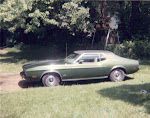Sunday, March 18, 2012
Normal:A Cartoon of Our Future?
Saga City has a cartoon showing how urban planning changed a hypothetical town, "Colvert." The description of how Colvert changes over time sounds eerily familiar: more neighborhoods being built outward from the town on farmland, a busy street around the town attracting more businesses and traffic until they needed a highway around that area to handle the extra traffic, zoning that separated different uses which required everyone to drive places, bigger houses with more stuff and more vehicles, and even a duck persistently seeking water throughout the video (we've got lots of ducks and geese around here, flying from one pond to another). But some of the changes also sound familiar: making streets and neighborhoods more bicycle- and pedestrian-friendly (helpful for a bike-riding Mayor!), filling in existing urban spaces instead of always building outward, creating more places to live near businesses, new uses for old buildings, and bringing "main street" back to life. So much of this describes Normal (well, we haven't yet made Veterans Parkway more friendly for people using any means of transportation). I don't think we're anywhere near the utopian ending shown in the video, but it does help to see how each of the changes helps to improve the community while still allowing people to have some choice in lifestyle.
Sunday, March 11, 2012
Normal Skyline
There are quite a few web sites featuring impressive skylines, like this one. Of course, Normal's skyline probably doesn't merit a picture on any of those sites. I think skylines without lots of buildings are worthy of attention. That's why I've posted a picture of one view of (northwest) Normal's skyline. While the foreground isn't much to look at, I like the view across the field and the line of power poles. No tall buildings, no water tower, no church spires. All of those things make for interesting skylines, too, but aren't always necessary. The full moon in this picture is just a nice addition. In just a year or so, this view will be very different, with at least one building being added (and probably more).
I like flat, field-dominated, Illinois skylines. I hope we can keep a few of them around Normal so we can appreciate a view without tall buildings, lots of signs, cell towers, and even wind turbines (which make for some interesting pictures, I admit).
I like flat, field-dominated, Illinois skylines. I hope we can keep a few of them around Normal so we can appreciate a view without tall buildings, lots of signs, cell towers, and even wind turbines (which make for some interesting pictures, I admit).
Tuesday, March 6, 2012
Normal Roundabout: Camping Prohibited
The Normal Town Council approved an ordinance prohibiting camping in the roundabout (aka Uptown Circle) as well as in the Gateway Plaza next to the Uptown Station (currently under construction). The reasons for prohibiting camping, as stated in the Town Council Action Report, are that these spaces were not designed for camping, camping would discourage pedestrian use, and camping might damage the property. People will still be able to use the spaces to "convey a public message" but not to camp/sleep there.
I guess it's for the lawyers to quibble about the definition of "camping." Does it necessarily mean staying overnight? Can't people camp during the day? Does it necessarily refer to sleeping? What if someone sleeps at the location during the day? What if they don't sleep overnight but keep actively conveying their message?
How should Normal balance encouraging people to use these wonderful public spaces while discouraging people from using them in a way that significantly interferes with the right-of-way and/or damages the properties? I like the image of these spaces as lively, popular places for public use but I agree that allowing overnight (non transitory) use does more harm than good. It will be interesting to see how public use of these spaces develops over the coming years.
I guess it's for the lawyers to quibble about the definition of "camping." Does it necessarily mean staying overnight? Can't people camp during the day? Does it necessarily refer to sleeping? What if someone sleeps at the location during the day? What if they don't sleep overnight but keep actively conveying their message?
How should Normal balance encouraging people to use these wonderful public spaces while discouraging people from using them in a way that significantly interferes with the right-of-way and/or damages the properties? I like the image of these spaces as lively, popular places for public use but I agree that allowing overnight (non transitory) use does more harm than good. It will be interesting to see how public use of these spaces develops over the coming years.
Subscribe to:
Comments (Atom)







